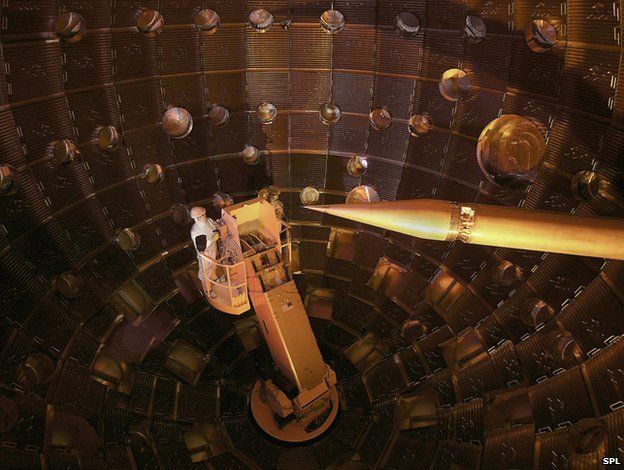Diamond crushed to Saturn's extremes
- Published

Diamond, nature's hardest material, has been crushed to record extremes of pressure using the "world's biggest laser", US scientists report.
The carbon crystal was condensed to the core pressure of Saturn - 14 times that at the centre of the Earth.
The big squeeze was performed inside the US National Ignition Facility, which recently featured in Star Trek.
It gives clues to the conditions deep inside giant, carbon-rich planets, says a study in Nature journal.
"We don't know what lies within the core of Jupiter or Saturn but now for the first time we now have the ability to study how matter exists under these extreme conditions of pressure and temperature," said lead author Dr Ray Smith, of Lawrence Livermore National Laboratory, California.
"Our experiments provide a method for recreating conditions within the cores of giant gas planets - both within our solar system and beyond.
"It has been proposed, for example, that Neptune has a diamond in its core, due to decomposition of methane which gets compacted under extreme pressure.
"The Kepler space mission has found Neptune-sized planets to be very common in our galaxy."
The planets and stars we see in the night sky were formed by powerful gravitational forces that crushed their constituent atoms tightly together.
The extreme pressures in their cores are expected to cause dramatic changes to the properties of matter.
How, on Earth, we can replicate these alien environments is a terrific challenge for scientists.
The US National Ignition Facility (NIF) was built to study inertial confinement nuclear fusion, and features 192 lasers which are used to bombard materials with energy.
Its target chamber famously doubled as the Starship Enterprise's "warp core" in the movie Star Trek: Into Darkness.
US researchers used NIF to compress carbon via a technique known as "dynamic ramped compression".
They focused 176 laser beams onto a millimetre-scale target diamond, held at the centre of a 10m aluminium sphere.
"The challenge in our experiments was keeping temperatures low enough to be relevant to gas giant planets like Jupiter," Dr Smith told BBC News.
"We accomplished this by carefully tuning the rate at which the laser intensity changes with time. The problem is similar to moving a plough slowly enough that sand is being pushed forward without building up in height."
The combined energy of the lasers (0.76 megaJoules, or MJ) created pressure waves in the diamond, compressing it to five terapascals (50 million atmospheres) - similar to the pressure at the centre of Saturn.
"Diamond - the least compressible material known, has here been compressed to an unprecedented density - more than that of lead," the authors write in Nature.
As the pressure increased, the researchers measured the stress, density and sound of the crystal carbon.
"These equation-of-state data can now be compared to.... theories long used to describe matter present in the interiors of giant planets and stars," they write.
At these extremes, a series of phase transitions is predicted to occur in which carbon becomes denser than in its diamond form.
"Interestingly, the experiments did not detect any of these phase transitions, which may have been smoothed out, or deferred, through some as-yet-unknown mechanism," said Dr Chris Pickard, University College London, writing in Nature.
"Overall, however, the agreement between results from [theoretical] calculations and the experiment is good, so the theory is likely to be on a solid footing."
Understanding conditions in Jupiter - such as whether its core is liquid or solid - will help solve arguments over how the planet formed.
"There are two standard models," Dr Smith told BBC News.
"The core accretion model suggests Jupiter was initially formed as a 10-Earth-mass body which had sufficient gravitational pull to trap and accumulate the large, thick hydrogen atmosphere we observe today.
"Another model, the giant instability model, proposes these giant gas planets were formed due to density instabilities which give rise to gravitational fluctuations and eventual clumping together of hydrogen gas - i.e. they formed without the need for a core."
Beyond our Solar System, there is evidence some exoplanets may have diamonds deep in their interior - such as 55 Cancri e, once dubbed the "diamond planet".
"Our data will help determine if these planets are indeed carbon-rich," said Dr Smith.
"If we want to understand which planets beyond Earth may ultimately be habitable, we must develop a broad understanding of all the possible end products of planet-forming processes."
However, Dr Pickard cautioned against putting too much weight on the results of the laser experiment.
"Planets form over many millions of years, whereas the reported dynamic ramped compression procedure is over in a flash," he told Nature.
"It is not clear whether these experiments, despite reaching relevant temperatures and pressures, are able to closely model the largely equilibrated, dense rocks and ices existing within giant planets."
Nevertheless, he encouraged the scientists to ramp up their experiment.
"Although the pressures and densities probed in the current experiments are immense, nature is even more ambitious. These giant exoplanets are a stepping stone to the stars, where petapascal pressures are reached," Dr Pickard said.
- Published14 October 2013
- Published8 December 2010
- Published25 December 2012
- Published16 February 2004